Landscaping: What is the Basis
Nature gives us three fundamental natural components of the garden - land, water, plants. Under the earth is understood not only its quantity and quality, but also the nature of the landscape. Therefore, the relief is the basis of the landscape landscape. It is the shape of the relief that tells the designer what principles of landscape design to apply, how to build a composition and which style decision to choose.

Begin designing your site only if you really “caught fire”. Theoretical knowledge matters little unless there is a great desire to translate their ideas
The relief is the most stable element of the garden landscape. From what it is, the remaining components will line up. Being engaged in the embodiment of landscape design on our site, we are dealing with a fragment of a natural landscape, into which we consciously introduce artificial changes.
We take a natural territory limited by a certain size, the appearance of which we form, taking into account the characteristic features of the relief, available landings, and soil quality. In gardens, which are located on a sloping terrain, large stones, boulders imitating a rocky surface are built into the slope. Curly perennials with a powerful root system are planted.

In landscape design, everything must correspond to each other so that a complete image emerges. Choose one basic idea and focus only on it

Build on the real needs of your family. Do not build antique columns like a neighbor if you do not need them
Thanks to these actions, the garden acquires an expressive artistic image and a wonderful appearance. In this case, it is clear that the designer found a successful combination of functionality and external beauty.
Content
- 1 The embodiment of art in landscape design. The main elements
- 2 The basic principles of landscape design
- 3 How to issue an entrance zone
- 4 Plot with a slope. Turn disadvantage into dignity
- 5 Video: example of successful implementation of your own landscape project
- 6 Photo: landscape ideas for inspiration
The embodiment of art in landscape design. The main elements
Each type of art has its own means of expressing creative intent. If this is painting, then the main means of finding an image is color; in sculpture, form. In landscape gardening art, where the basics of landscape design are applied, consisting in the joint creation of nature and man, the range of elements for creating an artistic image is more extensive. These elements are:
- wildlife objects - trees and shrubs, flowers, ponds;
- objects of artificial environment - small architectural forms (garden sculptures, paths, arches, arbors).
The mere presence of these elements on the site will not ensure the creation of an artistic image. In order to get a holistic, harmonious picture, everything must be done using the rules of landscape design and certain artistic ways of its embodiment are found.

Bet on natural materials to maximize your ownership of nature.

Design a place to relax first, and then fill the grounds with green spaces. So you get a comfortable structure, which later will also become a beautiful garden
The basic principles of landscape design
Before deciding on the layout and compositional aspects, you should familiarize yourself with the features of the territory.If your site has a complex shape, it’s possible to significantly simplify your work by using one approach - divide it into several simple zones. They can have a rectangular, semicircular, triangular or other shape.

A garden looks better if it has several clear lines. For example, a path or alley with trimmed bushes

The unity of style - if the house is decorated in rustic motifs, then the garden should correspond to it.
This approach helps to analyze the features of each of the zones of the territory and, having drawn conclusions, harmoniously compose the objects. All should be combined together adhering to certain design and artistic principles of landscape design.
| Symmetry principle, together with the principle of rhythmic contrast. | In this case, large and smaller garden objects alternate with each other in a geometric, strict design set by the designer. Creating a design, the designer is always looking for the “core” of the composition, its compositional center and “dominant points”. Based on this principle, for example, the following solution arises - the alley placed along the longitudinal axis of the rectangular section becomes the core. The center of the composition is a round arbor, with decorative elements. In the corners of the garden are four slender cypress trees. They will be the dominant points that close the composition. |
| Rhythm. | A simple manifestation of rhythm is the linear planting of bushes and trees repeated at regular intervals. The ease, completeness of perception of the composition of the garden depends on the skillfully found rhythm and placement of accents. To make a drawing of the garden more interesting, you can use the construction of a rock garden, terraces, arbors, creating a dynamic pattern of paving paths. |
| Flowing forms. | For those who are tired of the straightforward forms of urban buildings, when designing their site, use this principle. According to him, platforms, flower beds, paths, hedges have inherent soft outlines and curves characteristic of nature. |
| Nuance, contrast. | These are manifestations of opposite form, principles. Acting on the principle of nuances, a smooth, subtle transition is ensured, from the forms created by the designer to the natural landscape. When using contrasts, the opposite is true. Differences in forms are emphasized, silhouettes and outlines are contrasted. In contrast to the nuance, contrast has its own expressive features. |

The smooth bend of the garden path leading to the linden alley

Lush lawn mixborder mixborder
This is not all, but only the basic principles of landscape design. It is worth noting the principle of scale - the same architectural form will look different, depending on which garden is located. With the existing size of the site, measure the scale of the planned buildings, the height and shape of trees, shrubs and flower beds.

Mixed planting of tall trees to protect the site from the wind
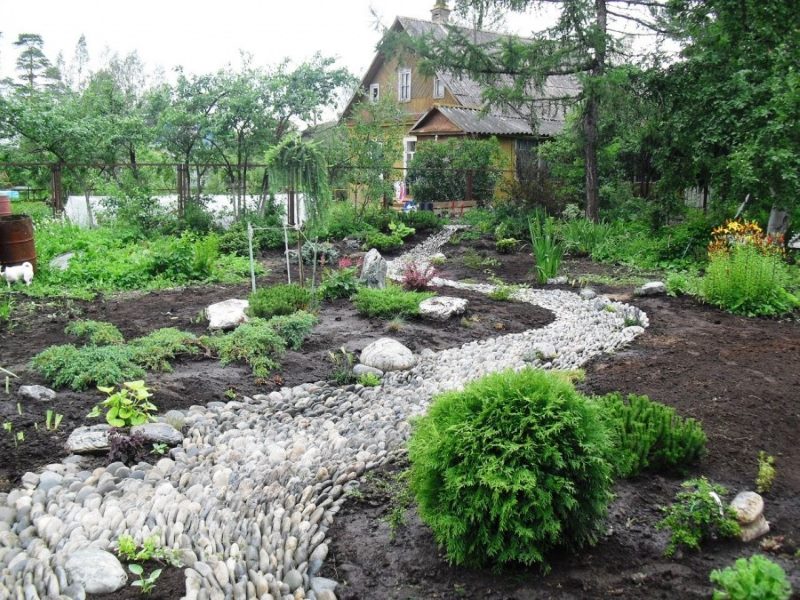
The center of the composition is a dry stream of stone
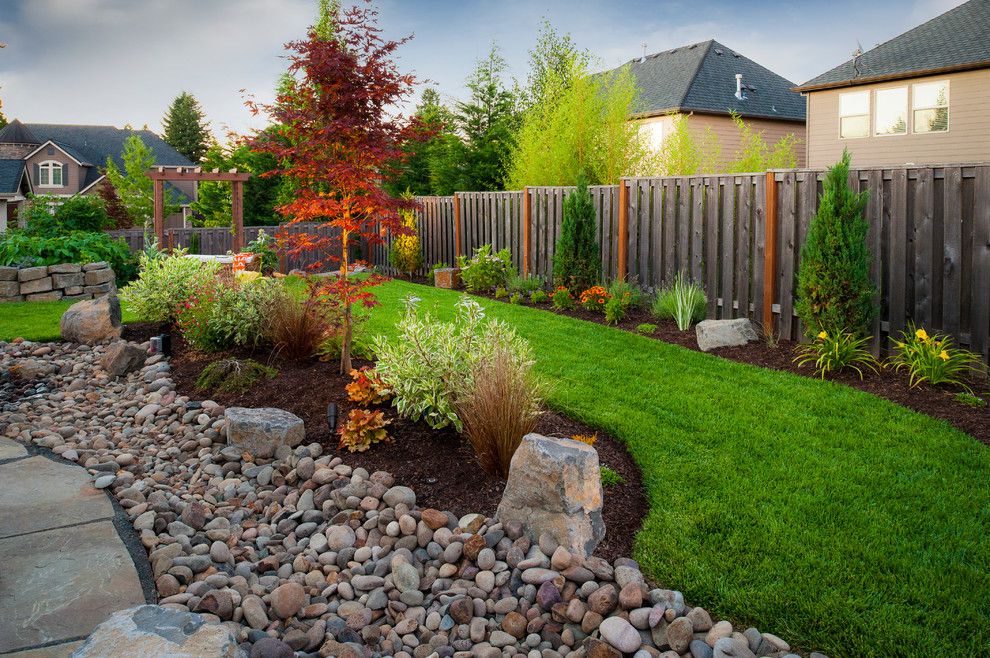
You can always add something new and interesting to the garden. The more different corners and original ideas, the better it looks.
How to issue an entrance zone
Conventionally, the site is divided into 3 zones:
- front part (entrance area and front garden);
- lateral;
- back (includes the courtyard).
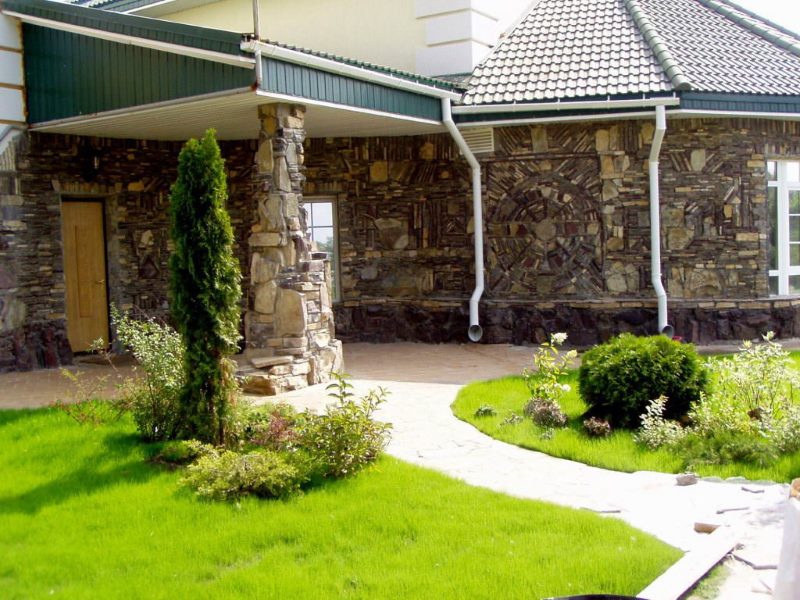
Dividing the site into zones creates a sense of order and aristocracy, like rooms in a house

Entrance area should not be overloaded with unnecessary details
Entrance zone - the face of the house, which judges the taste of residents, their lifestyle. The main functions of this part of the garden is to create a decorative effect, protect the interior of the garden and the house from dust, noise coming from the street.
In this area, most often they place different functional structures: a carport, a road to the garage, transformer boxes, sewage wells, and other communication devices.With proper placement and necessity, these elements are decorated with hedges, trellis with climbing plants.

A simple but very beautiful fence in front of the entrance to the garden

Elegant design of the front zone in oriental style

Coniferous plants at the entrance to the house are stable, do not require complicated care, they look solid at any time of the year
In the front part, it is customary to plant decorative shrubs, conifers. They are located in such a way that the plantings do not interfere with the penetration of sunlight into the windows of the house. Symmetrically planted spruce or fir can frame the entrance to the garden, and textured boulders will complement the composition.
It is also necessary to make sure that the entrance area is beautifully decorated at any time of the year. To do this, the front garden is broken with plants and flowers that complement each other in shades and flowering period. A hedge of boxwood will serve as an excellent framing of the walkway and garage entrance, paved with natural stone.
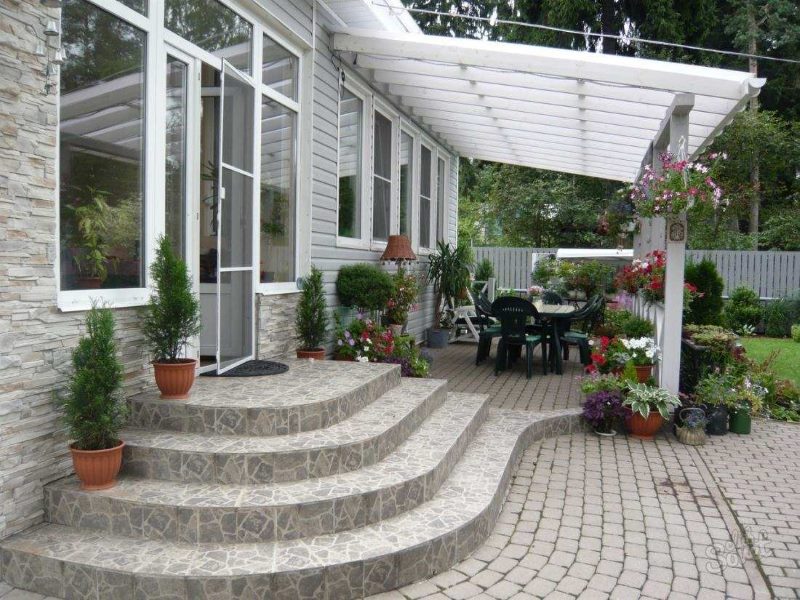
Lean on your inspiration, it’s the key to creating a truly stunning landscape
Plot with a slope. Turn disadvantage into dignity
Levels are often found inside the garden, but this is not a disadvantage. Masters of landscape design believe that the garden looks more attractive, the more diverse its relief. Designers will help to connect different levels with each other, change the existing terrain (remove or increase the slope), and form terraces.

Terraces are a popular way to give an incline to a stepped view, but work as long as the incline is not too large.
When implementing the transformations, several important points should be taken into account:
- It is harmonious to enter natural transitions with created vertical and inclined lines of stairs, slopes, retaining walls.
- When forming contour lines, try to ensure such a slope of the surfaces, at which there will be no flushing of the fertile soil layers. It is important that the slope is sufficient, contributes to the removal of excess rainwater, to prevent it from collecting in puddles in the middle of the garden.
- To carry out earthwork - to create the foundation. You need to make a terrain plan, create the main layer for backfilling or excavation, dig up holes and ditches, form slopes, fill up or remove the earth.

For a retaining wall of stone with a height of about half a meter, a foundation is not needed, proper laying and fastening with a mortar is enough

Retaining wall a meter or more high requires a certain competence in the construction industry
Their appearance can affect the aesthetics of the garden. They are built where there are slopes, there are large differences in relief, and terraces of different levels have been created. Most often, retaining walls are erected between the terraces.
The material from which the supports are made is natural stone, precast concrete elements and brick, if the wall height is small. The choice of material is understandable, as it allows you to create interesting architectural compositions, strong and durable.

Stone structures fit perfectly into the natural landscape and serve for many decades.

The wooden retaining wall is very interesting from a design point of view, but less durable even if hardwood is used
In addition to retaining walls, to fix the soil surface of the slopes, several methods are used: sowing grass, laying sod, planting bushes. Low retaining walls can replace garden benches. The erection of extremely high retaining walls should be avoided, due to a possible violation of the harmonious perception of the integrity of the landscape and to avoid additional costs.
Advice! It is better to replace a high wall with two, three lower. This will facilitate the transition between levels and will not introduce dissonance into the naturalness of the relief of the site.

When choosing plantations, give preference to plants growing in natural conditions on slopes and stones
In landscape design, there are many principles and methods on how to properly design your site. One article is not able to reflect all the information. If you have a small site, to embody everything on it will be inappropriate. Choose a few rules that you will follow that are appropriate to your worldview, the amount of money and the time you can spend. This will be enough to create your oasis!

Do you want to tinker with lawns, rockeries and alpine slides? Arrange a wild slope of stone and plants that prevent the soil from collapsing with its roots
Video: example of successful implementation of your own landscape project






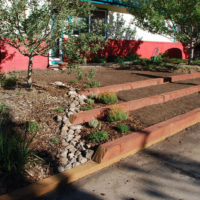





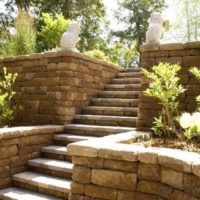






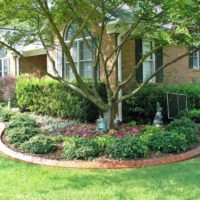

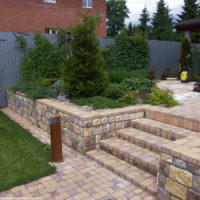

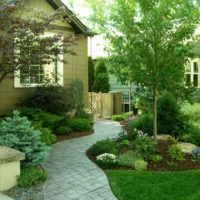








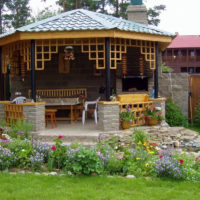





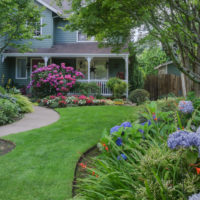





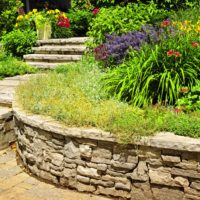




















Good day. Can you help? Plot 6 acres. Ivan tea and 60 young birches are growing. While there are no buildings